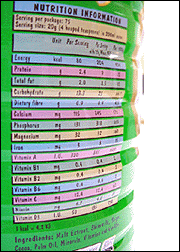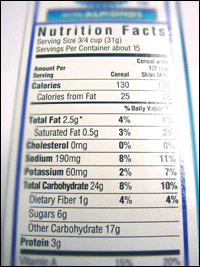You're finally organised to prepare nutritional meals for your family! Faith Chang of HealthAnswers tells you how to make informed food choices.
If you are not sure about how to read the nutrition information, the first thing to know is that there is a difference between a food label and a food nutrition label.
Food Label Versus Nutrition Information Panel
A food label tells you what type of food is inside the package, the amount of food in it, the country of origin and details of the manufacturer and local distributor.
 A food label has:
A food label has:
- A product name. This describes the food item in the package. It may provide some additional information about the product. For example, donuts and frosted donuts. This in itself tells you that the latter is the unhealthier alternative as it has sugar on it, and helps you differentiate between two similar products.
- An ingredient list: This gives what went into preparing the product. It is also useful to note that the ingredients are listed in descending order of the amount used, and by weight. Check it for the ingredients you want to avoid or get more of.
- Date markings. These are the 'Use By', 'Sell By', or 'Best Use Before' dates. This indicates the date up to which the product maintains its optimum quality from the shelf.
Check the date before you buy. 'Packed On' date is often seen on fresh produce and indicates the date the food was packed. Once the package has been opened, you cannot go by the date anymore. - Net Weight. This gives the actual weight of the food without the packaging. For canned foods packed in liquid, the net weight is the drained weight without the liquid. Compare the net weight of two similar products to get better value for money.
- Manufacturer's Details: every label includes the name and address of the manufacturer, importer or distributor.
- Usage Instructions: these are instructions for storing or using the product. Follow storage instructions such as 'Refrigerate after opening', which is part of the conditions that apply to the date marking. If the storage instructions are not followed, the product cannot be expected to last until the "Use By" date.
However, if you want to know about a product's nutritional value, or want to know how many grams of fat there are in a serving, turn to the nutrition information panel (NIP).
The NIP contains three main sections, namely the Panel Heading, Serving Size, and Nutrient Listing.
Bread Rolls 220g Net Weight
|
Nutrition Information |
|
Servings Per Package: 4
Serving Size Approx: 1 roll (55g) |
|
|
Per 55g serving |
Per 100g |
|
Energy |
609kj
145 kcal |
1107kj
264 kcal |
|
Protein |
5.6g |
10.2g |
|
Fat |
1.9g |
3.5g |
|
Saturated Fat |
1.0g |
1.8g |
|
Cholesterol |
0mg |
0mg |
|
Carbohydrate |
26.8g |
48.7g |
|
Fibre |
1.2g |
2.2g |
|
Sodium |
58mg |
106mg |
From the panel, we know the following:
- There are four servings (rolls) in the packet, each weighing 55 grams.
- Looking in the "per 55g serving" column, we can tell that each bread roll supplies 145 kilocalories (609 kilojoules) of energy. It also has 5.6 grams of protein, 1.9 grams of fat (of which one gram is saturated fat) and 26.8 grams of carbohydrate.
- The rolls contain no cholesterol as they have no animal products in them.
- Each roll contains 1.2 grams of dietary fibre.
- The rolls have 58mg of sodium each.
How Can The NIP Help Me Compare Foods And Plan My Meals? As a NIP lists the eight core nutrients namely: energy, protein, fat, saturated fat, cholesterol, carbohydrate, dietary fibre and sodium, this can help you assess how much of each of the nutrient is put into your body.
To compare the nutrients available in two similar products, refer to the "per 100g" column. This helps you ascertain the difference between their amount of energy they give you and the amount of fat they have.
You can also use the NIP to help you plan meals. Use the "per serving" column of the NIP and refer to a guide that tells you your recommended daily dietary intake.
Use the figures to work out how a food contributes to your daily nutrient needs.
 The Jargon Of Nutrient Claims
The Jargon Of Nutrient Claims
Although many products carry claims such as "high in fibre", "light", "lightly-salted", "reduced fat", or even "cholesterol free", what do they actually mean to different people with different nutritional needs?
Generally, here are the rules with the basic food groups:
Sugars
'No Added-sugars' or 'Without Added Sugar' mean no sugars and sugar containing ingredients such as honey, malt, glucose syrup or carbohydrate sweeteners, with the exception of sugar alcohol, are added during processing.
Unsweetened means no sugars or sugar containing ingredients such as honey, malt or sweetening substances and sugar alcohols are added during processing.
However, claims such as "sugar free", "low sugar" and "reduced sugar" have their own definitions of measurements. Diabetic patients should seek professional advice from their dieticians regarding sugars.
Other foods that are commonly available in healthier alternatives are milk, oil and meat. So, look out for the following definitions to help you.
Milk
There are basically three types of milk due to the differences in processing.
- Whole Milk - Whole milk is quite high in fat because milk is naturally that way.
- Reduced Fat Milk - has some of its fat removed.
- Skimmed Milk (i.e fat-free milk) - it has all the fat removed resulting in totally fat-free milk.
Who Can Take What: If your BMI is within the healthy range of 19-25,you can take whole milk. However, if you are overweight or are put on weight easily, it is best to take skim milk. Whole milk is also good for growing children who are not overweight. Pregnant women and lactating mothers who are not overweight are advised to take whole milk. The elderly should take skim milk as they put on body fat easily.
Cooking Oil
When buying cooking oil, it is best to choose one that has the claim, "Polyunsaturated Vegetable Oil" rather than "Vegetable Oil" as the latter may include palm or coconut oil, which is cheap to use. "Vegetable Oil" contains saturated fat, which is the main culprit of a high cholesterol level.
"Lean Meat" and "Extra Lean Meat" are also advised. "Lean Meat" has less than 10g of total fat in 100g of meat, whereas "Extra Lean Meat" has less than 5g of total fat in 100g of meat.
Other nutritional information
Low Calories foods - good if you're overweight, although it is okay for people within a healthy BMI range to eat such foods.
Low Fat foods - good if you're overweight.
Low Sodium/Lightly Salted - for people suffering from hypertension.
High Protein - for the physically active or if your job is physically demanding.

Ultimately, how fit you are depends on what you eat as well as what you do with the food you consume. It is also important to note that an active lifestyle should complement your dietary intake.
Health experts say aside from taking a well-balanced diet and a variety of foods, it is important to watch your calorie intake. Your calorie intake should be less than or equal to your output, which should include exercise and physical activities.
Date reviewed: 21 June 2000